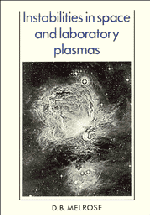Book contents
- Frontmatter
- Contents
- Preface
- Plasma formulary
- Part I Introduction to plasma theory
- Part II Instabilities in unmagnetized plasmas
- Part III Collision-dominated magnetized plasmas
- Part IV Instabilities in magnetized collisionless plasmas
- 10 Dispersion in a magnetized plasma
- 11 Electron cyclotron maser emission
- 12 Instabilities in warm and in inhomogeneous plasmas
- 13 Instabilities due to anisotropic fast particles
- Appendix A The plasma dispersion function
- Appendix B Bessel functions
- Appendix C Collision frequencies
- Appendix D Transport coefficients
- Bibliographical notes
- References
- List of commonly used symbols
- Author index
- Subject index
10 - Dispersion in a magnetized plasma
Published online by Cambridge University Press: 06 December 2010
- Frontmatter
- Contents
- Preface
- Plasma formulary
- Part I Introduction to plasma theory
- Part II Instabilities in unmagnetized plasmas
- Part III Collision-dominated magnetized plasmas
- Part IV Instabilities in magnetized collisionless plasmas
- 10 Dispersion in a magnetized plasma
- 11 Electron cyclotron maser emission
- 12 Instabilities in warm and in inhomogeneous plasmas
- 13 Instabilities due to anisotropic fast particles
- Appendix A The plasma dispersion function
- Appendix B Bessel functions
- Appendix C Collision frequencies
- Appendix D Transport coefficients
- Bibliographical notes
- References
- List of commonly used symbols
- Author index
- Subject index
Summary
Dielectric tensors
The inclusion of a magnetic field leads to a considerable increase in the richness and variety of the wave motions which can exist in a plasma. It also leads to a qualitative change in the orbits of the particles, which become spirals about the magnetic field lines. This affects the nature of particle-wave interactions. Not surprisingly, the generalization from unmagnetized to magnetized plasmas involves a marked increase in algebraic complexity of the relevant formulas. However the basic principles do not change.
In this Chapter the generalization (to the magnetized case) of the calculations of the dielectric tensor (§10.1) and of the quasilinear equations for wave-particle interactions (§10.5) are presented, and the properties of important classes of waves are discussed. The case of cold plasma wave modes is treated in a formal way in §10.2, the magnetoionic wave modes are discussed in §10.3, and low frequency wave modes are treated in §10.4. The waves discussed in detail in this chapter can nearly all be regarded either as magnetized versions of the waves in an unmagnetized plasma or as collisionless analogs of the MHD waves. There are other wave modes which are intrinsic to collisionless magnetized plasmas; some of these are discussed in Chapter 12.
For an unmagnetized plasma there are three equivalent methods for calculating the response tensors: the cold-plasma method (§2.1), generalized as discussed following (2.25), the Vlasov approach (§2.2) and the forward-scattering method (§5.5).
- Type
- Chapter
- Information
- Instabilities in Space and Laboratory Plasmas , pp. 163 - 183Publisher: Cambridge University PressPrint publication year: 1986
- 1
- Cited by



